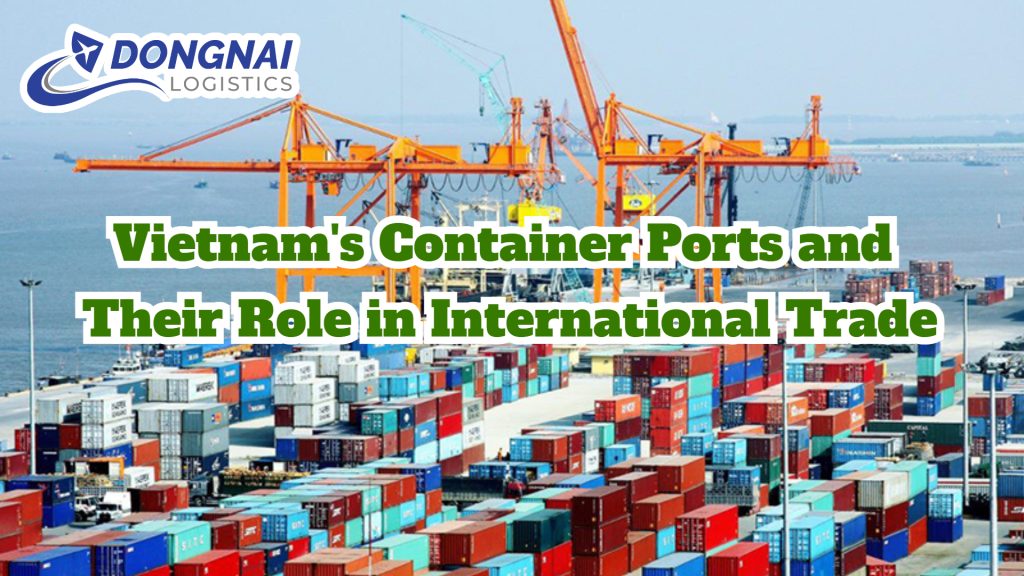Vietnam’s Container Ports and Their Role in International Trade
Vietnam’s container ports are increasingly asserting their importance in the global economy. Their strategic geographical location supports the development of Vietnamese ports, connecting Vietnam to global markets. This article will explore the role of container ports, highlighting the advantages of Vietnamese ports and examining the challenges faced by the port industry.
The Importance of Vietnam’s Container Ports
Vietnam’s container ports are at the heart of the logistics system and global cargo transportation. Major ports such as Hai Phong, Ho Chi Minh City, and Da Nang help Vietnam become a crucial link in the global supply chain. These ports facilitate the export of goods and the receipt of products from other countries, optimizing international shipping routes. Vietnam’s container ports play a vital role in connecting global markets effectively.
Vietnam’s container ports are key stopovers for international shipping lines. These transport routes handle strategic goods exports and imports, such as agricultural products, seafood, textiles, electronics, and industrial products. This enhances the competitiveness of Vietnam’s economy. The connection with international ports allows Vietnam to leverage opportunities from free trade agreements (FTAs). Agreements like the CPTPP and EVFTA expand Vietnam’s access to international trade.

Advantages of Vietnam’s Ports
The advantageous geographical location contributes to the strong development of Vietnam’s container ports. With over 3,200 km of coastline, Vietnam has multiple sea gateways that connect easily to various regions worldwide. Large ports in Hai Phong, Ho Chi Minh City, Quy Nhon, and Da Nang help Vietnamese goods access international markets, especially in China, Japan, South Korea, and ASEAN.
Vietnam’s port infrastructure is improving and expanding. The Cai Mep – Thi Vai port, capable of handling large container ships, is a clear example of Vietnam’s port sector growth. These ports play an essential role in international trade by reducing transportation costs and delivery times, thus boosting global commerce.
International cooperation enhances the competitiveness of Vietnam’s container ports. These ports not only serve domestic vessels but also host large international shipping lines. This expands Vietnam’s trade relationships, increases export and import opportunities, and contributes to the country’s economic growth.
The Role of Vietnam’s Container Ports in International Trade
Vietnam’s container ports are crucial in international trade. Large ports facilitate the rapid, efficient, and safe transportation of goods. They not only handle the loading and unloading of cargo but also optimize logistics processes. This helps reduce costs and improve efficiency for businesses.
Ports create favorable conditions for export and import businesses. Vietnamese goods can easily access international markets due to the strong connection with shipping routes. Major ports serve as essential gateways for key products such as textiles, electronics, agricultural products, and seafood. This helps Vietnamese goods reach global markets effectively.
Container ports promote international trade through free trade agreements (FTAs). The signing of agreements like the EVFTA opens up export opportunities to demanding markets such as the European Union. At the same time, these agreements also facilitate the import of high-quality products, strengthening Vietnam’s ties with developed economies.
Challenges Facing Vietnam’s Container Ports
Vietnam’s container ports are facing several significant challenges. One key issue is the management and maintenance of port infrastructure. While major ports have been upgraded, maintaining and expanding infrastructure remains a challenge. Ports need modern handling equipment to meet growing demands. They also must ensure the ability to accommodate large container ships. Environmental protection in port activities is another important factor that must be addressed.
Another major challenge is international competition. Vietnam faces competition from large ports in Thailand, Singapore, and Malaysia. To maintain its advantages, Vietnam needs to improve port services and enhance logistics quality. Reducing operational costs is also crucial to staying competitive.

The Future of Vietnam’s Ports
In the future, these ports will play an even more significant role in international trade. Investment in advanced technologies, such as automation, will help reduce costs and transportation time. Ports will operate more efficiently thanks to these improvements. Developing additional new shipping routes will connect Vietnam to larger markets, helping the country maximize the potential of its container ports.
Vietnam’s ports are integral to international trade. Their favorable geographical location and modern infrastructure offer significant advantages. These ports form strong connections with global markets, establishing Vietnam as a reliable partner in the global supply chain. For sustainable development, ports need to continue improving their infrastructure, enhancing service quality, and reducing costs to meet market demands.
Read More:
Vận tải biển: Xương sống của chuỗi cung ứng toàn cầu
Vải Vận Chuyển Từ Đồng Nai Sang Phần Lan Bằng Đường Biển
Vận chuyển hàng hóa từ Đồng Nai đi Phú Quốc
Chuyển phát nhanh từ Quảng Ninh đến Đồng Nai chất lượng, uy tín, giá cạnh tranh

